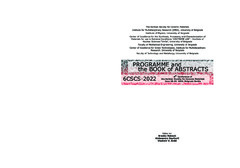Prikaz osnovnih podataka o dokumentu
Effect of the sintering technique on the properties of Sb-doped BaSnO3 ceramics
| dc.creator | Vukašinović, Jelena | |
| dc.creator | Počuča-Nešić, Milica | |
| dc.creator | Malešević, Aleksandar | |
| dc.creator | Ribić, Vesna | |
| dc.creator | Drev, Sandra | |
| dc.creator | Rečnik, Aleksander | |
| dc.creator | Bernik, Slavko | |
| dc.creator | Podlogar, Matejka | |
| dc.creator | Branković, Goran | |
| dc.date.accessioned | 2023-08-02T06:09:40Z | |
| dc.date.available | 2023-08-02T06:09:40Z | |
| dc.date.issued | 2022 | |
| dc.identifier.uri | http://rimsi.imsi.bg.ac.rs/handle/123456789/2026 | |
| dc.description.abstract | Barium stannate, BaSnO3 (BSO), a cubic perovskite-type oxide with its interesting structural, optical and electrical properties has wide application as an electrode material, thermally stable capacitor, transparent conductive oxide, photocatalyst, humidity and gas sensor material [1]. Partial substitution of Sn by Sb in BSO leads to drastic changes primarily in its electrical properties, resulting in metallic-like conductivity of doped ceramics. Major problems concerning the synthesis of Sb doped BSO (BSSO) are connected to the phase composition and density of final ceramic material. This study covers the comprehensive investigation of structural, microstructural and electrical properties of the Sb-doped BaSn1-xSbxO3 (x = 0.00, 0.04 and 0.08, BSSO) ceramic materials obtained by two different sintering techniques: conventional sintering (CS) and Spark Plasma sintering (SPS). The relative densities of the BSSO-CS ceramic samples sintered at 1600 °C for 3 h was in the range of 79– 96 %. On the other side, the relative densities of BSSO-SPS ceramic samples in the range of 86–96 % were obtained at 1200 °C, with sintering time of only 5 minutes. The XRD analysis confirmed that cubic BaSnO3 is a major phase in all BSSO samples. The presence of tetragonal Ba2SnO4 as a secondary phase was detected in BSSO-SPS ceramic samples, with its content decreasing upon Sb-doping. As expected, the grain size of the samples sintered at higher temperatures (BSSO-CS) is larger in comparison with BSSO-SPS ceramic samples, which was confirmed by Scanning Electron Microscopy (SEM). SEM analysis also revealed the layered structure within the grains of BaSn0.92Sb0.08O3-CS sample while HRTEM analysis confirmed the existence of the low angle grain boundaries (LAGBs) in the SPSed sample with the same composition. The electrical resistivity decreased upon Sb doping, and all doped BSSO samples showed the linear I-U characteristic in the temperature range of 25–150 °C. The semiconductor behavior of all BSSO-CS and BSSO-SPS (x = 0.00 and 0.04) ceramic samples was confirmed through the existence of semicircles in their impedance spectra. On the other hand, the BaSn0.92Sb0.08O3 sample showed the metallic-like behavior resulting from the loss of the electrostatic barriers at LAGBs, which is manifested through the absence of the semicircle in its impedance spectra. | sr |
| dc.language.iso | en | sr |
| dc.publisher | University of Belgrade, Institute for Multidisciplinary Research | sr |
| dc.rights | openAccess | sr |
| dc.rights.uri | https://creativecommons.org/licenses/by-nc-nd/4.0/ | |
| dc.source | 6th Conference of the Serbian Society for Ceramic Materials, 6CSCS-2022, June 28-29, 2022, Belgrade, Serbia | sr |
| dc.subject | Barium stannate | sr |
| dc.subject | Sintering technique | sr |
| dc.subject | Spark plasma sintering | sr |
| dc.subject | LAGBs | sr |
| dc.subject | Electrical properties | sr |
| dc.title | Effect of the sintering technique on the properties of Sb-doped BaSnO3 ceramics | sr |
| dc.type | conferenceObject | sr |
| dc.rights.license | BY-NC-ND | sr |
| dc.identifier.fulltext | http://rimsi.imsi.bg.ac.rs/bitstream/id/5342/bitstream_5342.pdf | |
| dc.identifier.rcub | https://hdl.handle.net/21.15107/rcub_rimsi_2026 | |
| dc.type.version | publishedVersion | sr |

